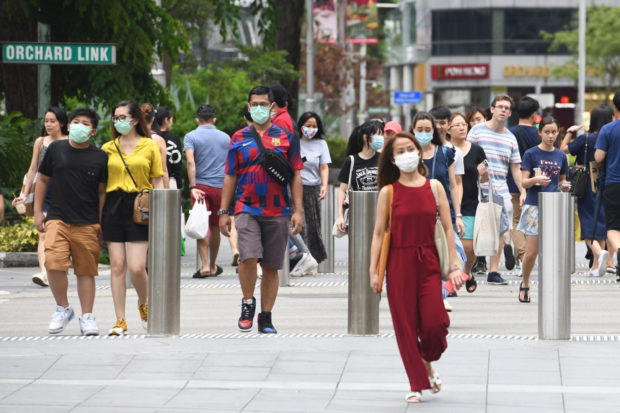
People wear facemasks to try to halt the spread of the COVID-19 coronavirus as they walk through a shopping district on Orchard Road in Singapore on April 5, 2020. Singapore will likely propose a new protocol that would allow for a cross-border movement of people once the COVID-19 pandemic shows a downward trajectory. AFP/Roslan Rahman via The Jakarta Post/Asia News Network
JAKARTA — Once the COVID-19 pandemic shows a downward trajectory and countries in Asean region starts to reopen, Singapore will likely propose a new protocol that would allow for a cross-border movement of people.
Singapore’s Ambassador to Indonesia Anil Kumar Nayar said in a press briefing on Monday that Asean countries should sit down and explore new procedures that would allow citizens to travel in the region.
“Before reopening, we need to have a common set of checklist of cross border rule before we can open border. This will take time but worth exploring,” Kumar Nayar said.
He said that ASEAN countries could look to efforts taken by countries like Australia and New Zealand to discuss a travel hub that could soon restart travel between the two countries.
The envoy was quick to add that cross-border travel between Asean countries could only start if local transmission of COVID-19 could be put under control and mortality rate has reached a low level.
Since April 7, Singapore has introduced what it called as “circuit breaker” measures, an elevated safe-distancing measures that would last until June 1. During the circuit breaker period, only food establishments, markets and supermarkets, clinics, hospitals, utilities, transport and key banking services, are allowed to remain open.
Recently, the city state has seen a spike in the number of coronavirus cases among its migrant workers community.
Singapore, a country with 5.7 million people has nearly 15,000 confirmed coronavirus infections, one of the highest totals in Asia, largely because of outbreaks in cramped dormitories housing more than 300,000 mostly South Asian workers.
Authorities have ramped up tests for members of the foreign workers communities and made moves to isolate those contracting the virus.
While the testing rate for members of local community is 2,100 per 100,000 persons, the number in foreign workers community is 6,000.


